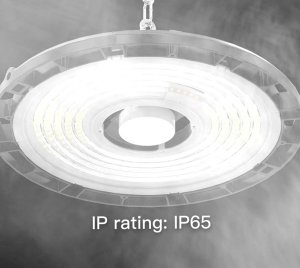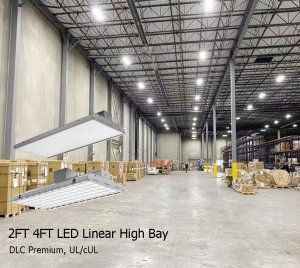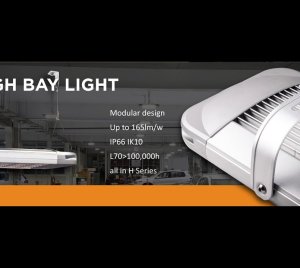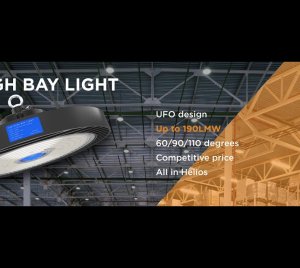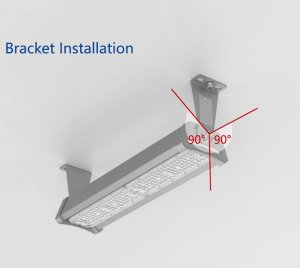-
Welcome to submit your products to the Media module of Open Lighting Product Directory (OLPD). OLPD editors work free of charge to review your submissions and add the approved product listings to appropriate OLPD categories for lifetime exposure. To be able to make a submission and get it approved, please read this guide.
High Bay and Low Bay Lights
High bay and low bay lights are types of lighting fixtures designed for illuminating spaces with high ceilings and are commonly used in industrial and commercial settings. High bay lights are designed to illuminate spaces with ceilings higher than about 20 feet (6 meters). These fixtures are typically found in very large spaces where the light needs to travel a long distance to reach the ground. Low bay lights are used in spaces with ceilings that are less than 20 feet (about 6 meters) high. The term "bay" in its original context refers to an interior subspace that is outlined by a structural framework or skeleton of the building. Such spaces are usually designed for specific functions within industrial settings, such as manufacturing, assembly, or storage areas. In the context of the lighting industry, however, the meaning of "bay" has broadened. It no longer strictly refers to these skeleton-framed spaces in industrial facilities. Instead, "bay" has come to denote almost any large interior space that requires lighting. This expansion in meaning is likely due to the functional needs and applications of lighting in various large spaces, not just those with an industrial framework. For instance, spaces like warehouses, large retail environments, sports arenas, or exhibition halls may all be considered "bays" in the lighting context because they similarly require extensive and often specialized lighting solutions to cover large areas efficiently and effectively. This usage reflects the industry's adaptation to the diverse needs of different types of large spaces beyond traditional industrial settings.
High bay and low bay lighting applications are very diverse. Common in manufacturing facilities and warehouses, high bay lights are essential for ensuring adequate illumination from high ceilings. They help workers see clearly, which is crucial for safety and productivity in environments where machinery and equipment are operated. Large commercial spaces such as supermarkets and department stores often use high bay lighting to provide bright, uniform light across extensive areas, enhancing the shopping experience and highlighting products. Gyms, indoor sports arenas, and pool areas benefit from high bay lights due to their ability to cover large areas without shadows, making them ideal for both safety and visibility during physical activity. High bay lights are used in exhibition centers and event halls due to their high ceilings and the need for broad, consistent lighting to accommodate large crowds and various events. Low bay lights are ideal in environments with lower ceilings where detailed tasks are performed. They provide bright and even light that helps in reducing eye strain and improving accuracy in tasks. In retail environments with lower ceilings, low bay lighting can enhance the appearance of merchandise, attract customers, and create a welcoming environment that encourages shopping. Adequate lighting in storage rooms and utility areas is crucial for safety and efficiency. Low bay lights provide sufficient illumination for easy navigation and organization in these spaces. Schools and colleges use low bay lights in areas like libraries, cafeterias, and some classrooms, where the balance of light is important for comfort and functionality. The diversity in applications of high bay and low bay lighting is a reflection of their flexibility and adaptability to different environmental conditions and needs, ranging from industrial safety to commercial aesthetics.
The shift towards LED technology in high bay and low bay lighting applications has been driven by the significant advantages that LED lights offer over traditional lighting technologies like incandescent, fluorescent, and high-intensity discharge (HID) lamps. LED lights are considerably more energy-efficient than traditional lighting solutions. This efficiency stems from LEDs' ability to convert a higher percentage of electrical energy into light rather than heat. Traditional technologies such as incandescent bulbs waste much of their energy as heat, which is not the case with LEDs. In practical terms, this means that LEDs use less power to produce the same amount of light, leading to lower electricity costs and a reduced environmental impact. LED lights have a significantly longer operational life compared to conventional lighting options. This extended lifespan reduces the frequency of replacement, which is particularly advantageous in applications where lights are installed in difficult-to-reach places, such as high ceilings in warehouses or large retail spaces. The longevity of LED lights naturally leads to lower maintenance costs. Industrial and commercial facilities can save on both the cost of replacement bulbs and the labor involved in replacing them. This is especially beneficial in high bay and low bay settings where changing a light fixture may require specialized equipment like lifts or scaffolds and can disrupt normal operations. LED technology allows superior control over the light spectrum, including color temperature and color rendering. Unlike HID lamps that typically require a warm-up period before reaching full brightness, LEDs turn on instantly to full luminosity. Additionally, LEDs can withstand frequent switching on and off without affecting their lifespan, which is an advantage in areas where lights do not need to be on at all times. LEDs can be dimmed easily, which is not always possible with traditional lighting technologies. Dimming not only allows for further energy savings but also helps in creating adjustable lighting environments, enhancing the functionality and ambiance of a space. LEDs do not contain hazardous materials such as mercury, which is present in fluorescent lamps, making them safer for users and better for the environment. Additionally, their lower heat emission makes them safer to handle and reduces cooling costs in illuminated spaces.
The variation in designs of high bay and low bay LED lights is primarily driven by the different lighting needs and installation environments. Each type of linear high bay and low bay LED light offers unique advantages depending on the specific requirements of the installation site, including factors like ceiling height, ambient lighting conditions, and energy efficiency goals. Selecting the right type of high bay and low bay lights involves considering these factors to achieve optimal illumination while maximizing energy savings and maintenance benefits. Round or UFO style high bay LED lights are compact and round, resembling the shape of a UFO (Unidentified Flying Object), which is where the name comes from. They usually have a robust aluminum housing that helps in heat dissipation. These lights are designed for durability and ease of installation, typically hanging from the ceiling with a chain or hook. Linear high bay LED lights are elongated, rectangular fixtures that provide a broad spread of light, making them particularly well-suited for lighting large spaces with high ceilings. Standard linear high bays typically resemble the traditional fluorescent tube fixtures but outfitted with LED technology. They provide a broad spread of light, which is ideal for covering large areas evenly. Narrow aisle linear high bay lights are designed with optics that focus the light more directly to create a more concentrated beam spread. This design is effective for lighting narrow spaces more efficiently. These fixtures are particularly effective in tall, narrow warehouse aisles where light needs to be focused downward to avoid wastage and improve visibility between high racks. Linkable linear high bay lights can be physically and electrically connected to extend illumination over large areas without the need for additional power sources for each unit. This feature simplifies installation and can be ideal for customizing lighting layouts. They are useful in flexible or expanding operational areas, such as modular workspaces or temporary setups like trade shows. Low bay LED lights are often round, similar in shape to UFO high bay lights but scaled for lower ceilings. They often have a compact design with integrated heat sinks and are encased in durable materials to withstand various environmental conditions. They are ideal for areas like auto repair shops or small warehouses, where robust, efficient lighting is needed but without the extreme coverage or intensity of high bays. Linear low bay lights are elongated, similar to linear high bay lights, but with less intense light output suitable for lower ceiling applications. They are often designed to replace fluorescent tube lighting, offering better energy efficiency and a longer lifespan. They are suitable for grocery stores, kitchen areas, and other retail or service areas where bright, even light is needed across a broader area. Architectural low bay lights not only provide necessary illumination but also focus on aesthetics, featuring more attractive designs that can complement interior decor. They might use stylish diffusers and come in various shapes and colors.
The performance of LED luminaires, including high bay LED lights, relies heavily on the quality and characteristics of the LED packages incorporated into the system. High-power LED luminaires like high bays require robust designs to manage the thermal and electrical stresses associated with their operation, ensuring consistent performance and longevity in demanding lighting applications. The "package platform" refers to the specific design and construction of the LED chip and its encapsulation. Different package designs offer varying levels of efficiency, heat dissipation, color rendering, and other performance metrics. Metrics such as luminous flux (brightness), color temperature, color rendering index (CRI), efficacy (lumens per watt), and lifetime are critical factors in determining the overall performance and quality of LED luminaires. LED manufacturers often offer a range of LED packages with different specifications to meet the diverse needs of lighting applications, including high bay lighting. While mid-power LEDs may offer higher lumens per watt, they are more prone to degradation and failure in high power lighting systems due to their design limitations, including resin deterioration and lead frame corrosion. On the other hand, high power and CSP LEDs have a more robust architecture that enables them to withstand higher thermal and electrical stresses, resulting in better lumen maintenance and long-term reliability despite their slightly lower efficacy. Therefore, for high power lighting applications, high power and CSP LEDs are often considered a better investment in terms of longevity and performance.
LEDs have made significant strides in improving the efficiency of converting electrical power into optical power. This means that a higher percentage of the electrical energy supplied to the LED is converted into visible light. However, despite these improvements, LEDs still convert a significant portion of the electrical power they receive into heat energy rather than light. This inefficiency results in a considerable amount of heat being generated during operation. Proper heat dissipation is essential to ensure the longevity, performance, and reliability of LED lighting systems. Failure to adequately manage heat can lead to premature degradation, reduced efficiency, and even the risk of catastrophic failure. Effective thermal management in LED luminaires is essential for maintaining the junction temperature within safe operating limits and ensuring the longevity and performance of the LEDs. This involves controlling the drive current to prevent excessive heat generation and designing a thermal path that facilitates efficient heat dissipation away from the LED chip. The thermal management of high bay and low bay LED lights relies on the effective design and integration of key components within the thermal path. The MCPCB, featuring a metal core such as copper, serves as the foundation for mounting LEDs. Its high thermal conductivity facilitates the efficient transfer of heat generated by the LEDs. The TIM, which can be in the form of grease, epoxy, or a pad, is applied between the MCPCB and the heat sink. It minimizes interfacial thermal resistance, ensuring optimal heat transfer from the MCPCB to the heat sink. The heat sink is specifically designed to dissipate heat from the MCPCB into the surrounding environment. Through convection, the heat sink efficiently disperses heat, maintaining safe operating temperatures for the LEDs. To maximize the performance of heat sinks, it's essential to maximize the surface area of the boundary and employ effective aerodynamic design. This involves optimizing the geometry of the heat sink to enhance natural air circulation and increase convection surface area. Heat sinks for high bay luminaires are typically produced using casting, extrusion, or forging methods. These processes allow for the creation of complex shapes and structures necessary for effective heat dissipation. Among these methods, aluminum is the most commonly used material due to its cost-effectiveness, high thermal conductivity, and excellent processability. Passive heat sinking is preferred whenever possible due to its reliability and lack of noise. It relies on natural convection to dissipate heat, which can be efficient for moderate thermal loads. Since it doesn't involve moving parts like fans or blowers, passive cooling systems tend to be more durable and have longer lifetimes. Active heat sinking becomes necessary when the thermal load of an LED system is too high for natural convection alone to handle. Active cooling methods involve mechanisms such as fans, blowers, heat pipes, liquid cooling, Peltier devices, or synthetic jet cooling to enhance heat dissipation. These methods can significantly improve the heat transfer coefficient, allowing for better cooling performance.
LED drivers are crucial components in LED lighting systems, as they regulate the current flowing through the LEDs. Since LEDs are current-sensitive devices, their light output is directly proportional to the current passing through them. Therefore, the quality of the LED driver greatly impacts the performance and reliability of the lighting system. To maintain consistent light output regardless of fluctuations in supply voltage or forward voltage, precise constant current control is essential. This ensures that the LEDs operate at their optimal conditions and produce consistent illumination. Constant current drivers are employed in high bay LED systems to achieve this level of control. Constant current drivers for high bay and low bay LED lights are typically designed as switching power supplies (SMPS). SMPS drivers transform incoming power into pulse current by rapidly switching a pass element, such as a MOSFET, between its on and off states at a high frequency. This mode of operation minimizes power loss while providing stable current regulation. SMPS LED drivers are particularly suitable for medium to high power LED lighting solutions where efficiency is critical. Their efficient operation and precise current control make them the preferred choice for applications that cannot afford low power efficiency. The design and operation of SMPS for LED current control involve a combination of sophisticated components and features to ensure efficient, reliable, and safe performance. These include reactive components for energy conversion, EMI suppression techniques, power factor correction, various protection mechanisms, and overvoltage and over-temperature protection features. Despite the advantages offered by SMPS drivers, the market is drawn towards low-cost alternatives such as linear power supplies. Linear power supplies regulate DC power on resistive loads without relying on bulky and expensive reactive components. Linear power supplies operate with a constant headroom voltage, leading to inefficient power usage. The headroom voltage is wasted as heat, resulting in additional thermal stress on LEDs in DOB systems. This inefficiency can be particularly problematic for high power LED systems designed to produce a high volume of lumens, leading to economic losses. It is challenging to achieve universal input compatibility and galvanic isolation with linear power supplies, limiting their versatility and safety features. These drawbacks may outweigh the initial cost savings, particularly in high-performance LED systems designed for high bay lighting applications.
Lighting controls are essential for optimizing energy usage and creating comfortable environments in buildings. LED lighting, with its instant response to changes in current, is well-suited for various lighting applications. LED drivers often incorporate dimming capabilities using methods such as PWM and CCR, along with traditional dimming techniques like phase control dimming, to provide flexibility and precise control over light output. Historically, lighting control systems often utilized analog protocols like 0-10V and 1-10V for dimming circuitry. These protocols allowed for basic dimming control by varying the voltage signal sent to the fixtures. In recent years, there has been a shift towards digital communication protocols such as DALI, Bluetooth mesh, ZigBee, and Z-Wave due to their advanced features, flexibility, and ability to simplify and automate lighting control processes. These protocols offer bidirectional communication, enabling enhanced functionality and making it easier to configure, manage, and maintain lighting systems. The integration of advanced controls such as daylight harvesting controls, occupancy sensors, time clocks, and energy management systems into high bay and low bay lighting systems empowers automated operation with adaptable levels of control. These sophisticated controls enable the optimization of energy usage, enhance user comfort, and contribute to sustainability efforts. By leveraging these technologies, high bay and low bay luminaires can dynamically respond to changing environmental conditions, occupancy patterns, and scheduling requirements, ensuring efficient lighting while minimizing energy consumption and reducing operational costs. Overall, the inclusion of such controls represents a significant advancement in lighting technology, offering greater flexibility, convenience, and environmental responsibility in industrial and commercial settings. The effort to realize the energy savings potential of lighting controls is propelling the integration of industrial and commercial LED luminaires into building automation systems and IoT platforms. This integration enables more intelligent and efficient management of lighting resources, contributing to overall energy conservation and sustainability in industrial and commercial buildings.
How a luminaire performs under harsh environmental conditions serves as a crucial indicator of its overall performance and durability in industrial settings. These conditions, which may include exposure to water, moisture, dust, and corrosive elements present in the atmosphere, can significantly impact the reliability and lifespan of lighting fixtures. In industrial settings, where luminaires are often exposed to challenging conditions such as high humidity, airborne contaminants, and corrosive substances, it is essential for high bay lights and low bay lights to be specifically designed and constructed to withstand these adversities. Luminaires intended for use in hostile environments should be constructed using materials and design features that offer robust protection against water ingress, moisture buildup, dust infiltration, and corrosion. This may involve the use of sealed enclosures, corrosion-resistant coatings, gaskets, and other protective measures to ensure the longevity and reliability of the lighting fixtures. By ensuring that luminaires are able to withstand environmental extremes, industrial facilities can minimize the risk of premature failure, downtime, and maintenance costs associated with replacing damaged or malfunctioning lighting fixtures. Additionally, reliable performance under adverse conditions helps to maintain safe and productive working environments for personnel in industrial settings.


